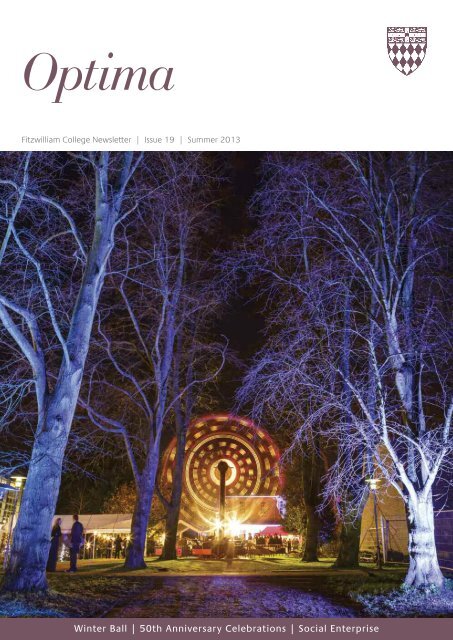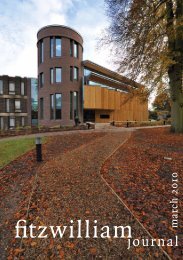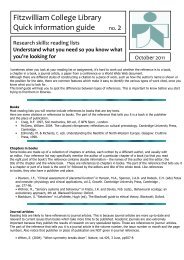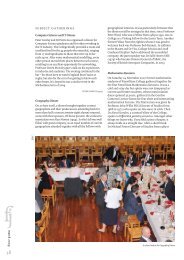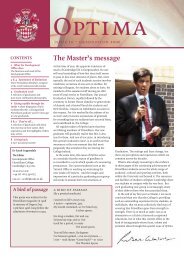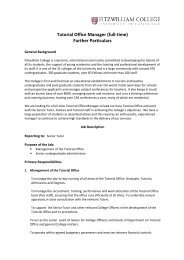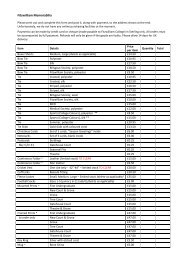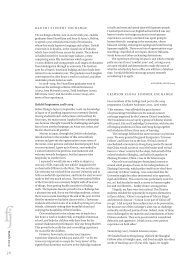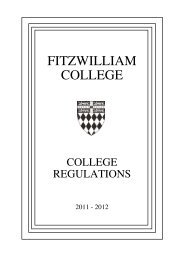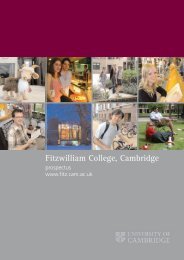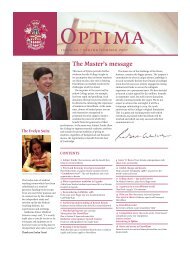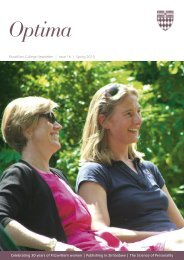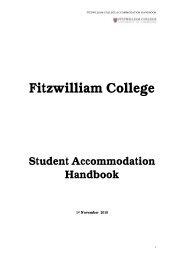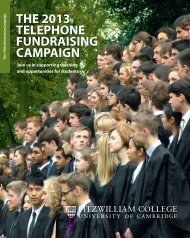Optima 19 (PDF) - Fitzwilliam College - University of Cambridge
Optima 19 (PDF) - Fitzwilliam College - University of Cambridge
Optima 19 (PDF) - Fitzwilliam College - University of Cambridge
Create successful ePaper yourself
Turn your PDF publications into a flip-book with our unique Google optimized e-Paper software.
<strong>Optima</strong><br />
<strong>Fitzwilliam</strong> <strong>College</strong> Newsletter | Issue <strong>19</strong> | Summer 2013<br />
Winter Ball | 50th Anniversary Celebrations | Social Enterprise
Master’s message<br />
My imminent<br />
retirement, on<br />
30 September, lends<br />
these habitual prefatory<br />
words an inevitably<br />
valedictory tenor. At<br />
least in personal terms.<br />
This issue <strong>of</strong> <strong>Optima</strong><br />
serves to remind me<br />
what a pleasure and<br />
privilege it has been to<br />
be part <strong>of</strong> <strong>Fitzwilliam</strong><br />
for so many decades.<br />
I was first elected as a Fellow <strong>of</strong> the <strong>College</strong> in<br />
<strong>19</strong>73. I have thus been witness to a large part <strong>of</strong><br />
the half-century since the move to the Huntingdon<br />
Road site ten years before. We have celebrated that<br />
special anniversary this summer in the shape <strong>of</strong> a<br />
superb architectural exhibition and a reunion <strong>of</strong> the<br />
Golden Matriculants <strong>of</strong> <strong>19</strong>63, also timed to<br />
welcome Lord Sainsbury, as Chancellor <strong>of</strong> the<br />
<strong>University</strong> and our own Visitor, to <strong>of</strong>ficially name<br />
The Olisa Library. Even those <strong>of</strong> us associated with<br />
<strong>Fitzwilliam</strong> for a long time saw the <strong>College</strong> anew as<br />
its successive architects detailed the narrative <strong>of</strong> its<br />
(literal) building, in itself a remarkable achievement<br />
in which alumni can take enormous pride.<br />
Yet, however much we may marvel at its physical<br />
transformation, the <strong>College</strong> is obviously much more<br />
than that. <strong>Optima</strong> continues to testify to the<br />
richness <strong>of</strong> its life and work. Its Fellows exemplify<br />
research innovation and academic distinction. Its<br />
students, past and present, excel in sport, organize<br />
major international occasions, win prizes in many<br />
disciplines and places, publish books, enlighten us<br />
in the media. <strong>Fitzwilliam</strong> now has a vastly increased<br />
number <strong>of</strong> postgraduates and they too are<br />
engaged in the public domain, some <strong>of</strong> them as far<br />
away from <strong>Cambridge</strong> as it is possible to get. And<br />
readers will find here yet further evidence <strong>of</strong> the<br />
personal generosity <strong>of</strong> alumni all too aware that,<br />
with the withdrawal <strong>of</strong> taxpayer support, we have<br />
to help ourselves if we are to sustain what is so<br />
valuable about a collegiate education and<br />
experience. On the other hand, it was always thus.<br />
The commemorative volume, <strong>Fitzwilliam</strong>: the First<br />
150 Years <strong>of</strong> a <strong>Cambridge</strong> <strong>College</strong>, to be published<br />
in September tells (through both its text and<br />
wonderful illustrations) a remarkable story, in which<br />
so many <strong>of</strong> the current activities have precedents.<br />
Masters come and go. What is as certain is that<br />
<strong>Fitzwilliam</strong> will go from strength to strength.<br />
Pr<strong>of</strong>essor Robert Lethbridge<br />
Master (2005 -13)<br />
<strong>College</strong> News<br />
Photo: Daniel Bates<br />
Pr<strong>of</strong>essor<br />
Richard Hooley<br />
has been<br />
elected as the<br />
next President<br />
<strong>of</strong> the <strong>College</strong>.<br />
The President<br />
deputises for<br />
the Master in the latter’s absence or<br />
illness. A <strong>University</strong> Lecturer from <strong>19</strong>93<br />
to 2003, Richard then moved to King’s<br />
<strong>College</strong> London as a Pr<strong>of</strong>essor <strong>of</strong> Law.<br />
He has been a Fellow for 23 years and<br />
has held a variety <strong>of</strong> posts including<br />
Director <strong>of</strong> Studies in Law, Tutor,<br />
New Master<br />
In March, the Governing Body elected Mrs<br />
Nicola (Nicky) Padfield MA Dip Crim DES as<br />
the next Master, to take <strong>of</strong>fice on 1<br />
October 2013. She has been a Fellow <strong>of</strong><br />
<strong>Fitzwilliam</strong> since <strong>19</strong>91 and is Reader in<br />
Criminal and Penal Justice in the Faculty <strong>of</strong><br />
Law at the <strong>University</strong> <strong>of</strong> <strong>Cambridge</strong>. She<br />
was called to the Bar in <strong>19</strong>78, and is a<br />
Recorder <strong>of</strong> the Crown Court and a<br />
Bencher <strong>of</strong> the Middle Temple.<br />
“I am delighted and honoured to be entrusted with this responsibility.<br />
I am eager to devote much <strong>of</strong> my energy over the coming years to<br />
<strong>Fitzwilliam</strong>, building on the outstanding work <strong>of</strong> Robert Lethbridge.<br />
The <strong>College</strong> is an extraordinary community <strong>of</strong> talented people,<br />
extending well beyond its current students and beyond <strong>Cambridge</strong>.<br />
On a more personal level, it will also be a happy return for my<br />
husband, Christopher - who was an undergraduate in the <strong>College</strong>.”<br />
Her first trip, as Master, will be to Hong Kong and Singapore where she will be<br />
hosting receptions in early January.<br />
New <strong>College</strong> President<br />
Contact the Editor<br />
Steward and Senior Tutor. He continues<br />
to supervise second year law students<br />
for contract law.<br />
“Nicky Padfield and I have worked<br />
together as Law Fellows for<br />
22 years and I very much look<br />
forward to continuing to work<br />
with her as she takes up her<br />
new position as Master.”<br />
Richard takes over from Pr<strong>of</strong>essor<br />
Nigel Slater on 1 October.<br />
Alison Carter | optima@fitz.cam.ac.uk | +44 1223 330784<br />
Please feel free to contact me with comments, contributions and suggestions for the next issue.<br />
Cover image: Alan Davidson. Ferris wheel in front <strong>of</strong> The Grove, Winter Ball November 2012.<br />
Read more on page 5.<br />
2 <strong>Optima</strong>, <strong>Fitzwilliam</strong> <strong>College</strong> Newsletter<br />
For the latest <strong>College</strong> news, visit www.fitz.cam.ac.uk
New prospectus<br />
Fellows in Saudi Arabian<br />
collaboration<br />
Pr<strong>of</strong>essor David<br />
Cardwell and Pr<strong>of</strong>essor<br />
Nigel Slater are two <strong>of</strong><br />
the four principal<br />
investigators on a £1.9<br />
million project<br />
supported initially for<br />
three years by the King<br />
Abdulaziz City <strong>of</strong><br />
Science and Technology<br />
(KACST). KACST, which is<br />
based in Riyadh, Saudi<br />
Arabia, has awarded the funding to support a joint<br />
collaborative research centre, based in <strong>Cambridge</strong>,<br />
to be directed by Pr<strong>of</strong>essor David Cardwell<br />
(Department <strong>of</strong> Engineering, <strong>Cambridge</strong>) and<br />
Pr<strong>of</strong>essor Ibrahim S Al-Mssallem (KACST).<br />
<strong>Fitzwilliam</strong> Admissions Office launched a new undergraduate prospectus and<br />
course booklet to coincide with the Arts and Sciences open days in April.<br />
Written by Admissions Tutor Mary Young, the prospectus has also been viewed<br />
online more than 2000 times.<br />
Have a look on the website and let us know what you think.<br />
Palmes Académiques for Master<br />
Freshers from 2012 were<br />
photographed in subject<br />
groups to illustrate the<br />
course booklet.<br />
Pr<strong>of</strong>essor Robert Lethbridge was<br />
honoured as a Commandeur dans<br />
l’Ordre des Palmes Académiques,<br />
the highest rank in the Order, by the<br />
French Ambassador His Excellency<br />
Bernard Emié on 12 February 2013<br />
at the French Embassy in London.<br />
Pr<strong>of</strong>essor Lethbridge also lectured<br />
on ‘Manet and the Writers <strong>of</strong> his<br />
Time’ at the Royal Academy in<br />
London in March.<br />
To listen to the lecture go to: www.royalacademy.org.uk and search for Lethbridge.<br />
Last year, Pr<strong>of</strong>essor Cardwell attended, by special<br />
invitation, the Prime Minister’s Seminar on Nano and<br />
Advanced Materials at 10 Downing Street and has<br />
the picture to prove it!<br />
Pr<strong>of</strong>essor Slater has been appointed an Honorary<br />
Pr<strong>of</strong>essor <strong>of</strong> the Tianjin <strong>University</strong> <strong>of</strong> Science and<br />
Technology in China and an Advisor to the Tianjin<br />
Joint Academy <strong>of</strong> Biotechnology and Medicine.<br />
Fellows organise food<br />
security debates<br />
<strong>Fitzwilliam</strong> Fellows Dr Bhaskar Vira and Dr David<br />
Nally organised three public debates in London<br />
earlier this year as part <strong>of</strong> the <strong>Cambridge</strong> <strong>University</strong><br />
Strategic Initiative in Global Food Security. The aim<br />
was to engage the public, industry and policy<br />
stakeholders in some <strong>of</strong> the pressing questions<br />
regarding the security <strong>of</strong> food in the global context.<br />
The debates were on: Biotechnology, IP and 21st<br />
Century Crops; Smallholder Farming and the Future<br />
<strong>of</strong> Food and The Right To Food. The debates gave<br />
people the chance to hear from and question<br />
politicians, researchers and journalists on the issues.<br />
Foundation Lecture – Thursday 7 November 6.00 pm<br />
‘Double standards: Perspectives on life in public companies and public <strong>of</strong>fice.’<br />
This year’s Foundation Lecture is to be given by Ken Olisa OBE (Natural Sciences, SPS and Management <strong>19</strong>71).<br />
<strong>Optima</strong>, <strong>Fitzwilliam</strong> <strong>College</strong> Newsletter 3
FITZWILLIAM<br />
The first 150 years <strong>of</strong> a<br />
<strong>Cambridge</strong> <strong>College</strong><br />
The Master Pr<strong>of</strong>essor Robert Lethbridge writes:<br />
“<strong>Fitzwilliam</strong>’s unique spirit is inseparable from<br />
the successive stages <strong>of</strong> its development. What<br />
it has become, since its origins in 1869,<br />
testifies to the determination <strong>of</strong> generations <strong>of</strong><br />
students, Fellows and staff. The story is one <strong>of</strong><br />
determined self-help. It is your story and it<br />
continues to this day. In bringing together, out<br />
<strong>of</strong> the archive and personal collections,<br />
anecdotes, photos, prints and other<br />
memorabilia, this volume provides us with a<br />
permanent record <strong>of</strong> ‘The First 150 Years’ <strong>of</strong><br />
our own <strong>Cambridge</strong> college.” In his foreword<br />
David Starkey writes: “<strong>College</strong> histories can be<br />
complacent things. This one isn’t. Instead, like<br />
all the best histories, it reveals an<br />
uncomfortable but exciting truth: <strong>Fitzwilliam</strong><br />
isn’t what you think it is.”<br />
Dr John Cleaver has been a Fellow <strong>of</strong> the<br />
<strong>College</strong> since <strong>19</strong>71. The book contains new<br />
photographs by Alan Davidson.<br />
ORDER YOUR COPY NOW!<br />
Follow the links at<br />
www.fitz.cam.ac.uk/book<br />
to order online, or order by<br />
telephone from the publisher<br />
TMI Ltd on +44 (0) 20 7336<br />
0144 during UK <strong>of</strong>fice hours.<br />
£40 plus p&p.<br />
Fitz pioneers Access initiative<br />
In July, the<br />
inaugural<br />
week-long<br />
summer<br />
school run by<br />
the Kent<br />
Academies<br />
Network<br />
Ceri Jones (History <strong>19</strong>88) opened its<br />
doors at Tonbridge School to twelve<br />
talented Year 9 pupils – and four<br />
<strong>Fitzwilliam</strong> students who acted as their<br />
learning mentors.<br />
The summer school scheme is the<br />
brainchild <strong>of</strong> Ceri Jones (History <strong>19</strong>88),<br />
Second Master at Tonbridge School and a<br />
driving force in the Kent Academies<br />
Network (KAN), an innovative<br />
collaboration between six independent<br />
schools (including Tonbridge) and six<br />
academies from across Kent. In<br />
partnership with the Sutton Trust and<br />
<strong>Fitzwilliam</strong> <strong>College</strong>, KAN aims to help<br />
academically bright, ambitious young<br />
people successfully apply to top ranking<br />
universities in the UK. Students from lowand<br />
middle-income backgrounds in Year<br />
Music<br />
The 2012-13 season has seen another<br />
very busy round <strong>of</strong> events, with two<br />
performances from our ensemble-inresidence<br />
the <strong>Fitzwilliam</strong> String Quartet,<br />
a special 80th birthday concert for<br />
composers Hugh Wood, Alan Gibbs and<br />
Malcolm Lipkin, a week-long run <strong>of</strong><br />
Gilbert & Sullivan’s Princess Ida, two<br />
Alkan anniversary recitals from pianists<br />
Tom Wakefield and Jonathan Powell,<br />
and a Festival celebrating the 450th<br />
anniversary <strong>of</strong> the great Elizabethan<br />
composer John Dowland. This latter<br />
event in May drew performers, scholars<br />
and instrument makers from all over the<br />
world, culminating in an extraordinary<br />
final concert featuring Dame Emma<br />
Kirkby, the Rose Consort <strong>of</strong> Viols<br />
(pictured) and three <strong>of</strong> the world’s finest<br />
lutenists, Nigel North, Paul O’Dette and<br />
Elizabeth Kenny.<br />
Francis Knights, Director <strong>of</strong> Music<br />
9 are selected from the participating<br />
academies – which are non-selective<br />
schools – based on their academic<br />
potential. Once the students win their<br />
place in Year 9, they are then supported<br />
for the rest <strong>of</strong> their school career.<br />
Ceri Jones said: “There is nothing like<br />
this collaboration happening anywhere<br />
else in the UK and it is to be celebrated<br />
that Fitz is at the forefront <strong>of</strong> a new<br />
model <strong>of</strong> partnership that can only<br />
benefit bright and disadvantaged<br />
pupils from the state sector.”<br />
Mary Young, Admissions Tutor (pictured)<br />
said: “This scheme is absolutely in line<br />
with <strong>Fitzwilliam</strong>’s philosophy and I’m<br />
thrilled to be able to support it and be<br />
involved. Ceri raised the idea with me<br />
after attending<br />
<strong>Fitzwilliam</strong>’s annual<br />
Alumni Teacher<br />
conference, where the<br />
importance <strong>of</strong> finding<br />
talent wherever it lies<br />
was the hottest topic<br />
<strong>of</strong> debate.”<br />
The Rose Consort <strong>of</strong> Viols – playing at the<br />
Dowland Festival in May.<br />
Concerts, recitals and workshops are<br />
listed on www.fitz.cam.ac.uk/events<br />
term by term, and some <strong>of</strong> the<br />
principal forthcoming events are<br />
shown on the back page. For more<br />
details email music@fitz.cam.ac.uk<br />
4 <strong>Optima</strong>, <strong>Fitzwilliam</strong> <strong>College</strong> Newsletter
Student news<br />
Winter Ball success<br />
Nine hundred guests stepped through the wardrobe into <strong>Fitzwilliam</strong>’s ‘Narnia’ Ball on Saturday<br />
29 November. The Ball saw The Grove transformed into ‘Mr Tumnus’ Cave’, the Dining Hall into<br />
‘Cair Paravel’ and the Auditorium into the ‘White Witch’s Castle’. And the entrance to the Ball<br />
was, <strong>of</strong> course, through a wardrobe. Main stage acts included Truly Medley Deeply, Denim, and<br />
The White Ties. Congratulations to Simon Johnson (History 2010), President, and all the Winter<br />
Ball Committee!<br />
Photos: Alan Davidson<br />
Simon Johnson – President <strong>of</strong> the Winter Ball Committee<br />
<strong>Optima</strong>, <strong>Fitzwilliam</strong> <strong>College</strong> Newsletter 5
Innovators<br />
Virtual network computing<br />
Dr Andy Harter first developed Virtual Network Computing (VNC)<br />
in <strong>19</strong>95 and now the s<strong>of</strong>tware protocol is being used in more than a<br />
billion devices.<br />
If you’ve been on the receiving end<br />
<strong>of</strong> IT support, then you’ve probably<br />
benefited from Virtual Network<br />
Computing (VNC) without even<br />
realising it. The technology allows a<br />
computer screen to be remotely<br />
accessed and controlled from<br />
another device.<br />
<strong>Fitzwilliam</strong>’s IT department uses it to<br />
provide technical support to staff<br />
and so does Intel who integrate VNC<br />
on chips for PCs and laptops; and<br />
Google, who license VNC technology<br />
and expertise to enable remote<br />
access functionality from its Chrome<br />
products. It is available on virtually<br />
every type <strong>of</strong> device that has a<br />
screen, making it the most widely<br />
ported s<strong>of</strong>tware application. It is<br />
now an <strong>of</strong>ficial part <strong>of</strong> the internet,<br />
alongside web and email protocols<br />
and at the forefront <strong>of</strong> innovation in<br />
the automotive industry, where it is<br />
the standard for integrating<br />
smartphones with in-vehicle<br />
infotainment systems.<br />
2002 to commercialise the<br />
technology they’d developed.<br />
He appeared in <strong>Optima</strong> as the<br />
winner <strong>of</strong> the Royal Academy <strong>of</strong><br />
Engineering’s Silver Medal in 2010<br />
for his outstanding personal<br />
contribution to British engineering,<br />
and the company received its third<br />
Queen’s Award for Enterprise in<br />
April 2013.<br />
because <strong>of</strong> the engineering<br />
excellence and tenacious<br />
entrepreneurship required for them<br />
to have opened the door to<br />
countless new markets for new<br />
products and services. For a relatively<br />
small UK company with no external<br />
investors to have grown to work with<br />
the world’s biggest technology<br />
companies is truly inspiring.”<br />
VNC’s algorithms<br />
minimize the<br />
amount <strong>of</strong> data<br />
that needs to be<br />
sent – ensuring<br />
responsiveness<br />
and stability across any network and<br />
the internet. The underlying<br />
technology means that VNC s<strong>of</strong>tware<br />
can be adapted to any device that<br />
outputs graphical data – which<br />
means that the s<strong>of</strong>tware is also<br />
fundamentally ‘future-pro<strong>of</strong>’ and is<br />
likely to be fitted as standard on<br />
many devices and in many operating<br />
systems for years to come.<br />
Dr Andy Harter and colleagues<br />
founded the company RealVNC in<br />
Lily Bacon, Andy Harter and the Princess Royal at the Royal Academy <strong>of</strong> Engineering<br />
MacRobert Award ceremony. Photo: Rob Falconer<br />
Now RealVNC has received the Royal<br />
Academy <strong>of</strong> Engineering MacRobert<br />
Award. The award – a gold medal<br />
and £50,000 cash prize – is the<br />
longest-running and most prestigious<br />
in the field <strong>of</strong> engineering and was<br />
presented to CEO Dr Harter and his<br />
colleagues by HRH The Princess Royal<br />
in a ceremony at Battersea Power<br />
Station in July 2013.<br />
John Robinson FREng, Chair <strong>of</strong> the<br />
judging panel, said: “RealVNC was<br />
selected for the MacRobert award<br />
Andy Harter (Maths and Computer<br />
Science <strong>19</strong>80) was Director <strong>of</strong><br />
Engineering and Research at the<br />
AT&T <strong>Cambridge</strong> Laboratory<br />
where he led many hardware<br />
and s<strong>of</strong>tware projects and<br />
their successful commercial<br />
exploitation. He is responsible<br />
for VNC and its seminal role in<br />
establishing the remote access<br />
market through<br />
open-source initiatives.<br />
6 <strong>Optima</strong>, <strong>Fitzwilliam</strong> <strong>College</strong> Newsletter
Technology to protect<br />
friendly bacteria<br />
<strong>Fitzwilliam</strong> Fellow Pr<strong>of</strong>essor Nigel Slater is one <strong>of</strong> the researchers behind<br />
new vaccine technologies.<br />
Pr<strong>of</strong>essor Nigel Slater’s BioScience Engineering Group has<br />
been developing oral live bacterial vaccines to protect<br />
against Typhoid, Enterotoxigenic E. coli (ETEC- travellers<br />
sickness) and other infectious diseases. They have discovered<br />
a new technique for delivering the live bacteria to the<br />
intestine in a way that protects the desiccated bacteria<br />
from bile.<br />
The challenge for any oral vaccine capsule is in surviving<br />
enough <strong>of</strong> the digestive system to reach the lining <strong>of</strong> the<br />
lower intestine. Pr<strong>of</strong>essor Slater’s group has found that if<br />
dried bacteria in a vaccine capsule are mixed with bile-acidabsorbing<br />
resins (BARs), the bile in the lower intestine will be<br />
held back long enough for the bacteria to rehydrate and<br />
trigger the immune system.<br />
Water (blue) permeates capsule faster than bile (brown) allowing<br />
vaccine bacteria (green) to re-hydrate back to life.<br />
BAR enables live bacteria to colonise the gut and provide effective<br />
vaccination.<br />
Pr<strong>of</strong>essor Slater explained: “On rehydration, [bacteria] regain<br />
their natural protection to bile. When we started the<br />
project, this wasn’t known. But the finding opened a door to<br />
how we could create an oral vaccine that could survive in<br />
the digestive system and didn’t require cold storage. We<br />
realised that we needed a technology that would allow<br />
dried bacteria to rehydrate before the bile reaches it.”<br />
The vaccine itself consists <strong>of</strong> attenuated Salmonella bacteria<br />
that have been engineered to carry proteins from the<br />
bacterium that causes traveller’s diarrhoea – sometimes<br />
called ‘Delhi belly’. Salmonella enterica serovar Typhi is used<br />
because it is unusually good at passing through the wall <strong>of</strong><br />
the intestine to lymph nodes where it induces a strong<br />
immune response.<br />
The research has been done in partnership with<br />
biotechnology company Prokarium, and Phase I clinical trials<br />
are planned. One goal <strong>of</strong> the research is a dual vaccine for<br />
Enterotoxigenic E.coli (ETEC – travellers sickness ) and<br />
Typhoid. ETEC causes more than 350,000 deaths a year, and<br />
typhoid as many as 200,000 – both principally in the<br />
developing world. Pr<strong>of</strong>essor Slater’s colleague Krishnaa<br />
Mahbubani explained the need for oral vaccines: “Needlefree<br />
vaccination strategies are suited for use in developing<br />
countries – where needle-based vaccination can pose<br />
logistical challenges due to the lack <strong>of</strong> a cold supply chain.”<br />
Pr<strong>of</strong>essor Slater said: “This is<br />
a great example <strong>of</strong> the<br />
<strong>University</strong> working with<br />
industry, interpreting needs<br />
to create a viable product<br />
using real science. This<br />
formulation has the potential<br />
to be distributed to the four<br />
corners <strong>of</strong> the earth.”<br />
<strong>Optima</strong>, <strong>Fitzwilliam</strong> <strong>College</strong> Newsletter 7
<strong>19</strong>63-2013<br />
Celebrating 50 years<br />
I have been witness to a large part <strong>of</strong> the half-century since the<br />
move to the Huntingdon Road site in <strong>19</strong>63. We have celebrated<br />
that special anniversary this summer in the shape <strong>of</strong> a superb<br />
architectural exhibition and a reunion <strong>of</strong> the Golden<br />
Matriculants <strong>of</strong> <strong>19</strong>63, also timed to welcome Lord Sainsbury,<br />
as Chancellor <strong>of</strong> the <strong>University</strong> and our own Visitor, to<br />
<strong>of</strong>ficially name The Olisa Library. Robert Lethbridge, Master<br />
Central Building: south and west elevations. (RIBA Lasdun PB898/1/24, drawing 474/208A, 27.09.<strong>19</strong>61).<br />
Denys Lasdun at the Royal<br />
<strong>College</strong> <strong>of</strong> Physicians,<br />
London, <strong>19</strong>65.<br />
John Donat/RIBA Library Photographs<br />
Collection.<br />
The exhibition ‘Building <strong>Fitzwilliam</strong> <strong>College</strong> <strong>19</strong>63-2013: an architectural journey’ opened on 25 June with<br />
a well-attended symposium focused on Sir Denys Lasdun and the work <strong>of</strong> his successors: MacCormac<br />
Jamieson Prichard (now MJP Architects); van Heyningen and Haward; Allies and Morrison, and Edward<br />
Cullinan Architects (now Cullinan Studio). An introductory lecture,’Courts and community: Denys Lasdun’s<br />
<strong>Fitzwilliam</strong> House’ by architectural historian Dr Barnabas Calder, re-assessed <strong>Fitzwilliam</strong>’s place within<br />
Lasdun’s body <strong>of</strong> work. A panel discussion followed with architects Bob Allies, Joanna van Heyningen,<br />
Oliver Smith (who worked with Sir Richard MacCormac on the Chapel) and Johnny Winter <strong>of</strong> Cullinan<br />
Studio (project architect on The Olisa Library). Pr<strong>of</strong>essor David Dernie (Architecture <strong>19</strong>82 and former<br />
Fellow) was in the chair. Sadly neither Ted Cullinan – who had worked with Denys Lasdun on the original<br />
buildings – nor Sir Richard MacCormac were able to attend the symposium, but interviews with both<br />
architects are featured in the short film by Helen Bettinson and Benedict Clancy (NatSci 2009) which forms<br />
part <strong>of</strong> the exhibition.<br />
The film and lecture are available at www.fitz.cam.ac.uk/about/50th-anniversary-exhibition<br />
The <strong>College</strong> wishes to thank Lady Lasdun for permission to reproduce Denys Lasdun’s drawings and plans. The Denys<br />
Lasdun Archive is held at the RIBA Drawings & Archives Collections at the Victoria and Albert Museum and the RIBA<br />
Photographs Collection at 66 Portland Place, W1. A new website, Lasdun Online will go live in summer 2014.<br />
8 <strong>Optima</strong>, <strong>Fitzwilliam</strong> <strong>College</strong> Newsletter
Building <strong>Fitzwilliam</strong> <strong>College</strong><br />
<strong>19</strong>63-2013<br />
An Architectural Journey<br />
<strong>19</strong>63-2013<br />
Celebrating 50 years<br />
The exhibition, which runs until 11 October, celebrates <strong>Fitzwilliam</strong>’s<br />
50 years on the site. The curator, Pr<strong>of</strong>essor Richard Marks – who is<br />
also Keeper <strong>of</strong> the <strong>College</strong> Works <strong>of</strong> Art – outlines its scope.<br />
Half a century ago staff and students <strong>of</strong><br />
what was <strong>Fitzwilliam</strong> House relocated to<br />
a new site on the Huntingdon Road. In<br />
concept and scale, the buildings they<br />
occupied were a far cry from the<br />
Georgian house on Trumpington Street.<br />
Designed by Denys Lasdun, the<br />
architectural vocabulary was that <strong>of</strong><br />
Le Corbusier. Still functioning as they<br />
were intended, Lasdun’s courts and<br />
Central Building have set the tone for<br />
the subsequent development <strong>of</strong> the site,<br />
including the most recent addition,<br />
The Olisa Library.<br />
As part <strong>of</strong> the celebrations <strong>of</strong> the 50th<br />
anniversary <strong>of</strong> the <strong>College</strong>’s taking<br />
possession <strong>of</strong> the new buildings, there is<br />
an exhibition in the chapel crypt<br />
devoted to its architectural<br />
development to the present day. The<br />
display focuses on the design and<br />
construction processes <strong>of</strong> the successive<br />
architectural practices involved, drawn<br />
from their records and the <strong>College</strong><br />
archives – but the primary exhibit is <strong>of</strong><br />
course the <strong>College</strong> itself.<br />
The exhibition has three elements.<br />
Firstly a chronological display <strong>of</strong> plans,<br />
designs and photographs <strong>of</strong> the<br />
successive phases <strong>of</strong> expansion, from<br />
the Grove Estate on the site, through<br />
Denys Lasdun’s Central Building and two<br />
courts fronting Huntingdon Road to<br />
New Court, the Chapel, Wilson Court,<br />
Gatehouse Court and Auditorium and<br />
The Olisa Library. Not overlooked is the<br />
contribution made by the imaginative<br />
landscaping and planting <strong>of</strong> the site,<br />
as a result <strong>of</strong> which there is an almost<br />
seamless fusion between the traditional<br />
<strong>Cambridge</strong> formal grassed court and a<br />
garden rich in different species <strong>of</strong> plants<br />
and flowers, so conceived that each<br />
open space and cluster <strong>of</strong> buildings<br />
retains its own discrete character. The<br />
final section sees the wheel come full<br />
circle and is devoted to the planned<br />
refurbishment <strong>of</strong> Lasdun’s Central<br />
Building.<br />
The second feature is a series <strong>of</strong><br />
architects’ models <strong>of</strong> the site and<br />
specific buildings; the third consists <strong>of</strong><br />
film and slide shows. One screen shows<br />
enlarged and supplementary images<br />
(including unexecuted designs for the<br />
enlargement <strong>of</strong> the <strong>College</strong>) and places<br />
the first building phase in the context <strong>of</strong><br />
<strong>19</strong>60s architecture in <strong>Cambridge</strong> and<br />
the new universities; the second screen<br />
shows a 15-minute film featuring<br />
specially-recorded interviews with<br />
almost all the architects and Christopher<br />
Pratt, former Bursar, who were involved<br />
in the commissioning and execution <strong>of</strong><br />
the successive phases.<br />
<strong>Cambridge</strong> architecture <strong>of</strong> the <strong>19</strong>60s<br />
on the whole has not enjoyed wide<br />
critical acclaim – the ‘New Brutalism’ is<br />
a common epithet. Recently a<br />
revisionist view has begun to emerge,<br />
one which sees the buildings <strong>of</strong> this<br />
epoch as historically significant, indeed<br />
ground-breaking, and <strong>of</strong> aesthetic merit<br />
in their own right. <strong>Fitzwilliam</strong> <strong>College</strong> is<br />
a prime document <strong>of</strong> this period, one<br />
which, while it has evolved in a s<strong>of</strong>ter<br />
fashion from Lasdun’s original concept,<br />
nonetheless has remained faithful to his<br />
scale, proportions and materials, a<br />
heritage which the <strong>College</strong> has always<br />
striven to maintain.<br />
It is not on the traditional <strong>Cambridge</strong><br />
tourist map and hence is largely<br />
unknown to visitors – even students<br />
from other colleges. For them and even<br />
current students and alumni it is hoped<br />
that the exhibition will be revelatory<br />
and the buildings and their settings be<br />
given their rightful due. In the words <strong>of</strong><br />
a recent critic, <strong>Fitzwilliam</strong> “is wellpreserved,<br />
carefully-detailed,<br />
beautifully-gardened.”<br />
Although each subsequent phase in the <strong>College</strong>’s development has its own distinctive imprint and is <strong>of</strong><br />
its time, the matrix was established by Lasdun’s design, scale, materials and palette. Pr<strong>of</strong>essor Richard Marks<br />
<strong>Optima</strong>, <strong>Fitzwilliam</strong> <strong>College</strong> Newsletter 9
<strong>19</strong>63-2013<br />
Celebrating 50 years<br />
The 50th anniversary celebrations on Friday 5 July included<br />
the naming <strong>of</strong> The Olisa Library by Lord Sainsbury, the cutting<br />
<strong>of</strong> the turf for the new extension and a reception and dinner<br />
for alumni from <strong>19</strong>63, Fellows, students and staff.<br />
From left: Julia Olisa, Johnny Winter, Ted Cullinan, The Chancellor,<br />
The Master, Ken Olisa OBE.<br />
Thirty-three alumni, and their guests,<br />
attended the <strong>19</strong>63 reunion – several<br />
coming from abroad, including (left)<br />
Ajit Kanagasundram and his wife,<br />
Shyamala, from Singapore.<br />
From left: Christopher Brown (English<strong>19</strong>63);<br />
His Honour Judge Kenneth MacRae (Law<br />
<strong>19</strong>63) and Mona Turley; Mrs Rochelle<br />
Rottenberg and Pr<strong>of</strong>essor David Rottenberg<br />
(Biochemistry <strong>19</strong>63) came from the USA.<br />
Inside the Library on the first floor. Librarian Chris RobertsLewis<br />
(second from left) said: “I enjoyed showing the Chancellor, Ken and<br />
Julia Olisa, and their family, round our beautiful Library and the dinner<br />
afterwards was a very special occasion for all involved.”<br />
Head Gardener,<br />
Steve Kidger,<br />
shows the<br />
Chancellor round<br />
the gardens.<br />
Photos: JET<br />
Photographic<br />
Guests enjoying the exhibition.<br />
Thanks...<br />
“Lots <strong>of</strong> lovely memories particularly <strong>of</strong> our time at <strong>Fitzwilliam</strong> – thanks<br />
heaps for all that and for keeping me in touch through emails. It was very<br />
special for Anne as well, she loved staying at the <strong>College</strong> and for me it was<br />
the first time I had stayed there because I was in digs for three years.”<br />
Peter Rahr (Engineering <strong>19</strong>63) lives in New Zealand.<br />
“It was a great pleasure to be able to join in the celebrations and to hear<br />
Ken Olisa’s moving address. I also very much enjoyed renewing<br />
acquaintance with my contemporaries from all those years ago. I must<br />
compliment your Development Office on the commemorative booklet –<br />
an inspired idea which told me more about my friends than I would ever<br />
have gleaned about their careers over any casual chat over dinner or in<br />
the bar.” Graham Jones (Economics <strong>19</strong>63).<br />
From Ken Olisa’s<br />
after-dinner speech<br />
“A Darwinian question – on a scale <strong>of</strong> 1 to 10, how<br />
selfish are you? Don’t mislead yourself. We are all tens<br />
– driven by behaviours that give us satisfaction. What<br />
differentiates us is how each ten manifests itself. Some<br />
people mainly derive pleasure from disadvantaging<br />
others. The self-absorbed enjoy themselves regardless<br />
<strong>of</strong> anyone else. The rest are delighted by helping<br />
humankind. Respectively; sadists, introspectives… and<br />
philanthropists.The survival <strong>of</strong> our species depends on<br />
the kind outnumbering the mean. <strong>Fitzwilliam</strong> has been<br />
generous to Julia and me over the years and we are<br />
delighted to help assure its longevity with this gift.”<br />
10 <strong>Optima</strong>, <strong>Fitzwilliam</strong> <strong>College</strong> Newsletter
<strong>19</strong>63-2013<br />
Celebrating 50 years<br />
And looking to the future<br />
After half a century <strong>of</strong> continuous<br />
service Lasdun’s Central Building<br />
is in need <strong>of</strong> some serious<br />
refurbishment and upgrading.<br />
The first phase <strong>of</strong> the <strong>College</strong>’s plan to<br />
breathe new life into this fifty-year-old was<br />
marked by the Chancellor, Lord Sainsbury,<br />
cutting the turf for a new extension in the<br />
northeast corner <strong>of</strong> Fellows’ Court on 5 July.<br />
Domestic Bursar Tim Heath demonstrates turf cutting technique, while the Bursar,<br />
Andrew Powell runs through his notes.<br />
Alumni from <strong>19</strong>63, Fellows and staff admire the digging.<br />
Cullinan Studio’s visualisation <strong>of</strong> the<br />
new extension to the left <strong>of</strong> the<br />
Central Building. The extension will<br />
provide a direct link from the<br />
existing kitchens to the Old Library,<br />
to provide a new multi-purpose<br />
suite for dining, teaching and<br />
conference use.<br />
The new building nearing<br />
first floor level in August 2013.<br />
Donation kick starts the refurbishment <strong>of</strong> the Central Building<br />
The refurbishment <strong>of</strong> the Old Library, due for completion Spring 2014, has been brought forward thanks to a<br />
£100,000 donation from <strong>19</strong>79 matriculants Doug and Rachel Webb. Doug said: “We remember the Old Library from<br />
thirty years ago when we were undergraduates – lots <strong>of</strong> books and shelves and tables and not-so-hushed voices! It now<br />
feels incredible to kick-start this transformation that is just one part <strong>of</strong> the <strong>College</strong>’s phenomenal development.”<br />
The <strong>College</strong>’s plans for the rest <strong>of</strong> the Central Building including the Dining Hall – currently in progress with Cullinan<br />
Studio, architects <strong>of</strong> The Olisa Library – will be unveiled by the new Master next year.<br />
<strong>Optima</strong>, <strong>Fitzwilliam</strong> <strong>College</strong> Newsletter 11
That was then, this is now<br />
When we published a list <strong>of</strong> <strong>Fitzwilliam</strong> Olympians, we managed to miss Paul Fishwick (Law <strong>19</strong>56).<br />
Paul played in the GB Hockey team as goalkeeper in Rome <strong>19</strong>60 and Tokyo <strong>19</strong>64. <strong>Optima</strong> asked<br />
for his ‘then and now’ thoughts.<br />
Sport was a big part <strong>of</strong> the life <strong>of</strong> almost every youngster in<br />
the <strong>19</strong>50s, and ‘The Olympic Games’ still had a magic ring<br />
to it – and invitations from the British Hockey Board “to be<br />
a member <strong>of</strong> the GB hockey party for the Games” in Rome<br />
<strong>19</strong>60 and in Tokyo <strong>19</strong>64 were magic too. I was ecstatic –<br />
despite in <strong>19</strong>64 having to forfeit a week <strong>of</strong> holiday each<br />
year for the next three years to compensate for the time<br />
I needed.<br />
That’s one big difference, as big business and sponsorship<br />
has now made most athletes at least semi-pr<strong>of</strong>essional. The<br />
impact has been great in terms <strong>of</strong> performance standards<br />
and has probably been a great help to the development <strong>of</strong><br />
minority sports. Has it been detrimental? Perhaps not, for<br />
most athletes are only interested in being better than their<br />
opponents on the day and would run, fight, jump, lift, ride<br />
or play for nothing just to have the chance to do so.<br />
Some things are still unchanged: the sheer joy and<br />
satisfaction <strong>of</strong> performance and achievement felt by<br />
athletes and spectators alike, and the personal satisfaction,<br />
as a competitor, <strong>of</strong> rubbing shoulders with iconic names and<br />
feeling that you are to your sport what they are to their own.<br />
In Rome, I found myself in the athletes’ stand sitting next to<br />
Emil Zátopek on the day that his wife Dana won the silver<br />
medal for Women’s Javelin. When I asked for an autograph,<br />
he created a cartoon that they both signed, and then asked<br />
for my autograph. It was a great moment.<br />
“I played for Harborne Hockey Club in<br />
Birmingham, for Staffordshire, for the<br />
Midlands and then for England and Great<br />
Britain and the Olympic Team all in one<br />
fantastic year after graduating in <strong>19</strong>59.<br />
I still tremble with excitement just writing that<br />
and remembering how it all happened.”<br />
The differences are clearly reflected in the statistics for<br />
growth and globalisation: in <strong>19</strong>60 there were 5,348<br />
competitors (11% women) from 83 nations in 150 events.<br />
In 2012, there were 10,903 competitors (44% women) from<br />
204 nations and 302 events.<br />
The end <strong>of</strong> ‘amateur–only’ status, the need to create<br />
spectacle for the worldwide TV audience, and the use <strong>of</strong> the<br />
Games as a platform for politics have all put at risk the<br />
Olympic ideals visualised by Pierre de Coubertin. Olympic<br />
notions <strong>of</strong> peace and understanding through sport may be<br />
fragile, but the people, the spectators and the athletes seem<br />
to be having the last word. Sport is a great force for good.<br />
So long as the Olympic Games retain equality <strong>of</strong> opportunity<br />
for all players, impartial refereeing and judging, and fair play<br />
for winners and losers alike, it will continue to be so. Long<br />
live the spirit <strong>of</strong> London 2012.<br />
Paul came up to <strong>Fitzwilliam</strong> House after two years <strong>of</strong><br />
National Service, where he first played serious hockey. He<br />
captained Fitz Hockey, played for the Wanderers and the<br />
<strong>University</strong>, earning a Blue in his final year. He joined the GKN<br />
Group on a graduate apprenticeship, had a long career in<br />
general and senior management followed by board<br />
appointments elsewhere in the industry and business<br />
consultancy with the DTI.<br />
Paul in action at Hurlingham Park<br />
against Wales in March <strong>19</strong>60.<br />
The cartoon by Emil Zátopek, the Czech long-distance runner<br />
who is still the only man to win the 5,000m, the 10,000m and<br />
the marathon at the same Olympic Games – <strong>19</strong>52 Helsinki.<br />
In Hockey, almost everything is different from <strong>19</strong>60 and<br />
geared to speed and spectacle – the <strong>of</strong>fside rule, the blue<br />
surface and yellow balls, the taking <strong>of</strong> free hits/long<br />
corners/roll ins and goalkeepers’ protective kit. I was<br />
put out <strong>of</strong> competing in Rome after being hit full in the<br />
face by a rocket shot and spending three days in hospital.<br />
It wouldn’t happen today.<br />
12 <strong>Optima</strong>, <strong>Fitzwilliam</strong> <strong>College</strong> Newsletter
A glimpse into<br />
the world <strong>of</strong><br />
Candomblé<br />
In response to the Summer 2012<br />
anthropology feature, Paul Williams wrote<br />
to <strong>Optima</strong> about his time researching the<br />
Candomblé religion in Brazil.<br />
In the late <strong>19</strong>60s, shortly after discovering I was not cut out for<br />
banking, I travelled with my wife (a Girtonian) to Brazil to start<br />
research into a religion called Candomblé. Enslaved Africans,<br />
including Yoruba people, brought their beliefs with them when<br />
they were shipped to Brazil during the slave trade in the sixteenth<br />
century. It is still very much alive and has over two million<br />
followers.<br />
Candomblé is a generic term referring to the whole pantheon <strong>of</strong><br />
Yoruba deities each <strong>of</strong> whom ‘controls’ a different part <strong>of</strong> the<br />
world ranging from fertility and love to war, thunderbolts and<br />
hunting. Each god is associated with different herbs for healing all<br />
manner <strong>of</strong> ailments from general malaise to serious lifethreatening<br />
illnesses. Ceremonies take place at night in cult<br />
houses when drumbeats, chants and the scents <strong>of</strong> herbs invoke the<br />
gods to come down and<br />
incorporate themselves in<br />
the bodies <strong>of</strong> the faithful.<br />
The belief is that when<br />
someone falls into a trance<br />
they forsake their normal<br />
identity and become a<br />
god with considerable<br />
power to heal illness.<br />
Initially the practice <strong>of</strong><br />
Candomblé was banned<br />
but slaves soon learned<br />
how to appease their<br />
masters by calling each <strong>of</strong><br />
their gods by the name <strong>of</strong><br />
Oxun, linked to the Virgin Mary.<br />
a Christian saint. They<br />
discovered at least one feature, however insignificant or small,<br />
that established a link between the Yoruba god and a specific<br />
Christian saint. Oxossi, for example, god <strong>of</strong> hunting,<br />
understandably became associated with Saint George the dragonslayer<br />
as there is an obvious association between the two; the<br />
beautiful fertility goddess Oxun finds a parallel in the Virgin Mary.<br />
The slaves’ quarters were the first centres <strong>of</strong> Candomblé operating<br />
late at night after the day’s labour. Those slaves most highly skilled<br />
in the traditional practices became the first priests and priestesses<br />
Paul and his wife Rosie, Brazil, <strong>19</strong>69.<br />
who, on liberation in 1888, established permanent cult houses<br />
wherever there was a need. The richest houses came to feature on<br />
glossy tourist maps but there was no point in our visiting such<br />
places: their work was well documented; they had distinguished<br />
patrons among whom a renowned novelist, <strong>University</strong> pr<strong>of</strong>essors<br />
and even the State Governor.<br />
Our business was with poorer cult houses where we could observe<br />
how the lower strata <strong>of</strong> Brazilian society in suburbs and outlying<br />
villages used the cult house as a source <strong>of</strong> healing. Some priests<br />
immediately welcomed us; others, more reticent, guarded their<br />
secrets, feeling, quite understandably, that a secret divulged<br />
might result in less-efficacious cures. Speaking the language and<br />
involving ourselves in their everyday concerns gradually helped us<br />
gain their confidence and eventually we were allowed into as<br />
many cult houses as we wished.<br />
We saw a whole range <strong>of</strong> remarkable cures: one man with very<br />
severe elephantiasis seemed dead when he arrived strapped to his<br />
horse and had to be cut out <strong>of</strong> his clothes, but after two doses <strong>of</strong><br />
herbal treatment he rode away unassisted. Another healer laid<br />
hands on cancer patients and arrested the onward creep <strong>of</strong> the<br />
disease. There were countless other examples. We were the first<br />
outsiders to witness these extraordinary practices and what we<br />
learned was so new at the time and so unusual that we <strong>of</strong>ten<br />
wondered where it would all end. Hopefully this book will<br />
stimulate further attempts at understanding the remarkable<br />
forces at work.<br />
Paul Williams (Modern Languages <strong>19</strong>65)<br />
did his PhD in Afro-Brazilian Studies at St<br />
Andrews and taught for many years at<br />
Winchester <strong>College</strong>. Now retired, he<br />
divides his time between a former<br />
chocolate factory, just yards from<br />
Winchester Cathedral, and an olive<br />
mill in the hills between Granada<br />
and Málaga. His memoir<br />
The Banker who Turned to<br />
Voodoo was<br />
published in 2012.<br />
www.thebankerwhoturnedtovoodoo.com<br />
www.bbc.co.uk/religion/religions/candomble<br />
<strong>Optima</strong>, <strong>Fitzwilliam</strong> <strong>College</strong> Newsletter 13
Members’ news<br />
Social Enterprise<br />
City Gateway<br />
Eddie Stride (Geography <strong>19</strong>99) planned to join HSBC when he left<br />
<strong>Fitzwilliam</strong>, but an encounter with street violence near his Tower<br />
Hamlets home made him change his mind.<br />
“I grew up in a poor family richly<br />
imbued with community activism, and<br />
that incident reminded me that I wanted<br />
to go back to my roots and make a<br />
difference.”<br />
In September 2012 City Gateway partnered with the London<br />
Evening Standard to encourage leading international firms to help<br />
combat youth unemployment and take on paid apprentices.<br />
To date over 250 NEET young people have started in life-changing<br />
apprenticeships at leading businesses including banks, financial<br />
When Eddie Stride joined City Gateway, the charity was on the point<br />
<strong>of</strong> closure. But the organization’s work with disadvantaged young<br />
people in London’s East End struck a chord, and he raised £40,000<br />
from corporate sponsors to keep it going. Soon, he was appointed<br />
CEO by the charity’s trustees. That was in 2003. Today, City<br />
Gateway has an annual turnover <strong>of</strong> over £7 million, employs over<br />
160 staff and <strong>of</strong>fers the chance to learn skills, get on the career<br />
ladder and develop business ideas. Most <strong>of</strong> the young people that<br />
City Gateway works with are “NEETS” – Not in Education,<br />
Employment or Training – and the charity’s efforts have seen<br />
NEET numbers in Tower Hamlets fall from 15% <strong>of</strong> young people<br />
to just 6.7%.<br />
Eddie Stride photo: Matt Writtle<br />
service firms, law firms and even the House <strong>of</strong> Commons. But Eddie<br />
acknowledges that this is just the start: “My heart breaks when I see<br />
young people out <strong>of</strong> work and all their amazing potential going to<br />
waste. We will do our bit to make them job ready, but we<br />
desperately need more companies to respond…”<br />
www.citygateway.org.uk<br />
London City Steps<br />
In 2009 Loona Hazarika (Economics <strong>19</strong>88)<br />
co-founded London City Steps, an UnLtd<br />
award-winning social enterprise that trains<br />
young people from London’s poorest<br />
boroughs to become history tour guides –<br />
and then employs them.<br />
London City Steps has trained over 100 people<br />
to give specialist subject walks and have so far<br />
guided government departments, school kids,<br />
big businesses, charities and countless tourists. The young people<br />
acquire new skills, grow in confidence, value teamwork and have<br />
knowledge <strong>of</strong> their local community – skills which are valued by<br />
employers and stand out on a CV. Loona first volunteered at the<br />
British Museum as a tour guide for four years and then did a sixmonth<br />
VSO assignment as Marketing Adviser for the Genocide<br />
Memorial Centre in Rwanda where he set up an audio guide<br />
system and developed the country’s first NGO online donation<br />
capability.<br />
“I saw first-hand the power <strong>of</strong><br />
business in building lives shattered<br />
by the genocide – and I set up<br />
London City Steps when I got back<br />
to London.”<br />
www.londoncitysteps.com<br />
Do you have an inspiring social enterprise story to share?<br />
Email optima@fitz.cam.ac.uk<br />
14 <strong>Optima</strong>, <strong>Fitzwilliam</strong> <strong>College</strong> Newsletter
In Brief<br />
The 2012 Bernácer Prize<br />
The 2012 Bernácer<br />
Prize has been<br />
awarded to Pr<strong>of</strong>essor<br />
Nicholas Bloom<br />
(Economics <strong>19</strong>91)<br />
for his influential<br />
research<br />
contributions on the<br />
sources, dynamics<br />
and effects <strong>of</strong> policy and economic uncertainty<br />
on business cycles as well as on the<br />
determinants <strong>of</strong> good management practices.<br />
The Bernácer Prize is awarded annually to<br />
European economists under the age <strong>of</strong> 40,<br />
who have made outstanding contributions in<br />
the fields <strong>of</strong> macroeconomics and finance.<br />
Nicholas Bloom is Pr<strong>of</strong>essor <strong>of</strong> Economics at<br />
Stanford <strong>University</strong>.<br />
Burkina Faso rescue<br />
“The Burkina Faso delegation invited me to<br />
go around the track with them at the closing<br />
ceremony, and gave me their National Dress<br />
to wear.”<br />
When the Burkina Faso Paralympic team athletes<br />
arrived in London, they found themselves<br />
without accommodation. So Liam Conlon (SPS<br />
2007) – who had met the team while on a<br />
DFID programme after leaving Fitz in 2011 –<br />
looked after them at his family home. The<br />
‘rescue’ was reported on the BBC, CNN and ITV,<br />
and in the Guardian. Liam has now started a<br />
project with the Burkina Faso Paralympic<br />
Federation, to widen access to sport for disabled<br />
people – and has funding from DFID and from<br />
PwC, where he now works. In recognition Liam<br />
has been appointed to the United Nations<br />
Association International Service – he is its<br />
youngest-ever member.<br />
optima@fitz.cam.ac.uk<br />
All for the love <strong>of</strong> tennis<br />
Philip Brook (Maths <strong>19</strong>74) became Chairman <strong>of</strong> the<br />
All England Club in 2011. At the time he said: “Some<br />
people have described it as the best job in the world.<br />
If you enjoy tennis as much as I do, it probably is.”<br />
Alison Carter finds out more.<br />
Just over a<br />
month after the<br />
end <strong>of</strong> the 2013<br />
tournament,<br />
with its historic<br />
conclusion for<br />
British tennis,<br />
Philip Brook is<br />
already busy<br />
preparing for<br />
next year.<br />
“Once the tournament is over, we<br />
review what worked well and what<br />
worked less well and think about<br />
how to improve. This starts in<br />
September after we’ve been to the<br />
US Open – to share ideas with our<br />
opposite numbers.”<br />
At Wimbledon, they have just finished<br />
implementing an18-year master plan<br />
– including the new Centre Court<br />
ro<strong>of</strong>; and the next 15-year master<br />
plan is under development.<br />
Everything they do is designed to<br />
maintain The Championships as the<br />
premier tennis tournament in the<br />
world and on grass. “Improvements<br />
will involve a ro<strong>of</strong> for No 1 Court and<br />
other ways to enhance the player and<br />
spectator experience – there’s a long<br />
wish list.”<br />
So what does the best job in the<br />
world involve? “There are two main<br />
aspects. I’m the Chair <strong>of</strong> the<br />
organising committee <strong>of</strong> The<br />
Championships. We have a board <strong>of</strong><br />
12 – all members <strong>of</strong> the club – and a<br />
chief executive, Richard Lewis, and<br />
150 permanent staff, including 25<br />
ground staff; 15 ticketing staff, a<br />
marketing and IT department. But<br />
the buck stops with me.” And when<br />
the tournament is not running, it’s a<br />
members’ club. Membership is<br />
limited to 500, and there’s a very<br />
long waiting list. Each year’s singles<br />
champions are invited to join as<br />
Honorary Members. “It was<br />
wonderful to see how delighted<br />
Marion Bartoli was with her purple<br />
circular Members badge!”<br />
Although Philip Brook says it’s not the<br />
same as running a company because<br />
change can only be made once a<br />
year, they made £40m pr<strong>of</strong>it last year<br />
– ploughed back into the Lawn Tennis<br />
Association to develop British tennis.<br />
The pr<strong>of</strong>it comes not only from the<br />
TV rights (a peak audience <strong>of</strong> 17.3m<br />
watched Andy Murray defeat Novak<br />
Djokovic in 2013) and ticket sales,<br />
but also from catering for close on<br />
500,000 people who attend each<br />
year, drinking, amongst other things,<br />
over 25,000 bottles <strong>of</strong> Champagne.<br />
Wimbledon is the largest single<br />
annual sporting catering operation<br />
(1800 staff) carried out in Europe.<br />
And what about that famous win by<br />
Andy Murray, the first for a British<br />
man in 77 years? “Our primary<br />
objective is to run as good a<br />
tournament as we can, for it to be<br />
impeccable and excellent. But <strong>of</strong><br />
course we loved it!”<br />
Philip Brook, a former actuary,<br />
was Yorkshire tennis champion<br />
in <strong>19</strong>78, and in the three<br />
preceding years was a member,<br />
and captain, <strong>of</strong> the <strong>Cambridge</strong><br />
team which ran up a hat-trick <strong>of</strong><br />
victories over Oxford.<br />
Philip Brook was the guest speaker<br />
at the Sports Dinner on<br />
14 September 2013.<br />
<strong>Optima</strong>, <strong>Fitzwilliam</strong> <strong>College</strong> Newsletter 15
Members’ news<br />
Poles apart<br />
When student telephone caller Hannah Malcolm rang Pippa Whitehouse she was fascinated to hear about her work in<br />
the Antarctic … then Fellow Adam Chau mentioned graduate student Mia Bennett’s Arctic project. Here are their stories.<br />
From Algebra to Antarctica<br />
Who owns the Arctic?<br />
For the past year, I’ve been cycling down from <strong>Fitzwilliam</strong> to<br />
<strong>Cambridge</strong>’s Scott Polar Research Institute to study changes in the<br />
Arctic. The area around the North Pole is on the front line <strong>of</strong> climate<br />
change, a topic many <strong>of</strong> my colleagues study. But the region is also<br />
on the front line <strong>of</strong> experiments in governance, which is my area<br />
<strong>of</strong> research.<br />
Pippa Whitehouse on Observation Hill.<br />
I remember two things about my interview to read Maths at Fitz:<br />
the first was managing to flick the pen lid across the room whilst<br />
thinking about an answer – luckily Dr Potter seemed unfazed by<br />
this. The second was ending up discussing how melting ice<br />
contributes to sea-level rise … strangely this now forms the focus<br />
<strong>of</strong> my research!<br />
I study how the Antarctica Ice Sheet has changed in response to<br />
climatic changes over the last 20,000 years, and how this has<br />
affected global sea level. The ice sheet has shrunk by over 3 million<br />
km 3 during this period, and removing this mass <strong>of</strong> ice causes the<br />
land beneath to slowly rebound upwards at a few millimetres a year<br />
for several thousands <strong>of</strong> years, like a big balloon filled with treacle.<br />
In late 2011 I was lucky enough to travel to Antarctica to measure<br />
this rebound for myself.<br />
I spent 6 weeks on the ice as part <strong>of</strong> the POLENET project, which is<br />
installing GPS receivers across Antarctica to measure this slow<br />
rebound. 24-hour daylight and glistening snow in all directions<br />
made for a welcome change from an <strong>of</strong>fice filled with computers,<br />
and with internet access limited to a 50kb email connection, it was<br />
a fantastic chance to escape from modern life for a while. The GPS<br />
receivers are left in place for several years to reduce the error bars<br />
on this tiny measurement, so as the data start to come in it’s time<br />
to check whether my calculations match reality…<br />
Perhaps surprisingly, the seafaring states <strong>of</strong> China, Japan, and Korea<br />
seek to gain a foothold in the Arctic due to their commercial<br />
interests in shipping, hydrocarbons, and fisheries. The Northern Sea<br />
Route could shorten transit time between the Far East and Northern<br />
Europe by up to 40 per cent, while Russia’s Far East is home to large<br />
deposits <strong>of</strong> natural gas.<br />
East Asian interest in the Arctic is pressurising the Arctic Council, the<br />
region’s pre-eminent multilateral organisation, to reconsider how it<br />
cooperates with states traditionally perceived as non-Arctic – those<br />
without territory north <strong>of</strong> the Arctic Circle. In my masters<br />
dissertation, I challenged the assumed dichotomy between Arctic<br />
and non-Arctic states. Flows <strong>of</strong> capital, goods, and people are<br />
connecting Chinese consumers with mineral deposits in Greenland,<br />
for instance. Beyond that, however, the North Pacific Ocean actually<br />
forms an area that I argue constitutes Asia’s Arctic near-abroad, with<br />
China, Japan, and Korea all having a historic presence in its waters.<br />
Thus, even territorially, Asia is not as far from the Arctic as it seems.<br />
Mia Bennett (MPhil Polar Studies 2012)<br />
presented research on Korea’s interests in<br />
the circumpolar north at the Arctic Frontiers<br />
conference in Tromso, Norway with support<br />
from <strong>Fitzwilliam</strong> and the Gates <strong>Cambridge</strong><br />
Trust. She is pursuing a PhD in Geography at<br />
UCLA in her home state <strong>of</strong> California.<br />
Pippa Whitehouse, née Archer (Maths <strong>19</strong>96) is a Post-Doctoral<br />
Research Associate at Durham <strong>University</strong>, and has recently been<br />
awarded a 5-year NERC Independent Research Fellowship to study<br />
postglacial rebound in Antarctica. After this she will take up a<br />
lectureship in the Geography Department <strong>of</strong> Durham <strong>University</strong>.<br />
pippa.whitehouse@durham.ac.uk<br />
Possibly the world’s most scenic bus parking lot. Tromso, Norway. January 2013.<br />
16 <strong>Optima</strong>, <strong>Fitzwilliam</strong> <strong>College</strong> Newsletter
Graduate research<br />
Re-reading the English riots <strong>of</strong> August 2011<br />
Acts <strong>of</strong> abandon or social<br />
abandonment? Sam Strong<br />
outlines his approach to<br />
understanding England’s own<br />
moment <strong>of</strong> political unrest and<br />
its ongoing consequences.<br />
considers not only the victims <strong>of</strong> the riots, but those who<br />
gained from events. Using a critical geographical framework,<br />
the polarised presentations <strong>of</strong> the riots are pluralised through<br />
a recognition <strong>of</strong> the numerous actors and places involved.<br />
I do this by focusing on the question <strong>of</strong> moral and political<br />
responsibility.<br />
Sam Strong addressing alumni at the<br />
1869 Foundation lunch.<br />
The recent focus on the ‘Arab<br />
Spring’ uprisings in the media<br />
may have led us to forget<br />
about the five days <strong>of</strong> violence<br />
which occurred across our<br />
own urban spaces in August<br />
2011. Rioting occurred in<br />
London, Birmingham Manchester, Liverpool, Bristol, Nottingham,<br />
Leicester, Gloucester and many other places; there were five<br />
deaths, 186 police <strong>of</strong>ficers injured, an estimated £200 million<br />
damages and more than 3,000 arrests.<br />
Using landscape and discourse analysis my project seeks to<br />
reconnect the ‘acts <strong>of</strong> abandon’ <strong>of</strong> the 15,000 English rioters<br />
with ‘social abandonment’. By ‘social abandonment’ I refer to<br />
the tendency to remove the riots from the spaces and histories<br />
in which they were grounded. This erasure <strong>of</strong> geographical<br />
context has been used both during and after the riots to match<br />
broader political agendas. By reducing the riots to a morality<br />
story <strong>of</strong> good and bad, the actual and emergent events have<br />
been ignored, certain groups expulsed for ‘criminality, pure and<br />
simple’ and others celebrated as resilient and defiant citizens –<br />
<strong>of</strong>ten through familiar markers <strong>of</strong> gender, ethnicity and class.<br />
My research re-assesses the riots and associated events by<br />
re-humanising and re-politicising all those involved, and<br />
Two years have now passed since the riots, allowing a critical<br />
and reflective appreciation <strong>of</strong> what they meant and how they<br />
continue to be discussed – or altogether ignored. Whilst acts <strong>of</strong><br />
violence are hard to excuse, I argue that failure to engage with<br />
the geographical (in the broadest sense <strong>of</strong> the word) reasons<br />
behind their occurrence may increase the likelihood <strong>of</strong> further<br />
similar episodes. We need to understand why people acted as<br />
they did in order to address not only the effects but the causes<br />
<strong>of</strong> geographical inequalities in contemporary society.<br />
Sam Strong (Geography 2009) is completing his MPhil in<br />
Geographical Research before embarking on a PhD. He gave a<br />
talk about his work to alumni attending the 1869 Foundation<br />
Lunch in May 2013.<br />
ss893@cam.ac.uk<br />
Images from Twitter<br />
Left: The picture, which has already been viewed more than 100,000 times,<br />
was taken by Twitter user @Lawcol888 who gives his name only as Andy B.<br />
Friends don <strong>Fitzwilliam</strong> hats<br />
Robin Ellis (History <strong>19</strong>61, left), who is best known for playing the leading role in the BBC<br />
series Poldark, now lives in southwestern France with his American wife and a menagerie <strong>of</strong><br />
animals. His life-long passion for cooking plus a diagnosis <strong>of</strong> Type 2 diabetes led to writing his<br />
first cook book, Delicious Dishes for Diabetics: A Mediterranean Way <strong>of</strong> Eating.<br />
John Willis (History <strong>19</strong>65, right) was appointed Chairman <strong>of</strong> The British Academy <strong>of</strong> Film and<br />
Television Arts (BAFTA) in July 2012. John said: “<strong>Fitzwilliam</strong> was the perfect place to learn<br />
about cinema because every imaginable masterpiece, old and new, was available in<br />
<strong>Cambridge</strong>. So I spent most <strong>of</strong> my first year in darkened rooms watching movies. It is now<br />
standing me in good stead.”<br />
Listen to Robin Ellis talking about the international appeal <strong>of</strong> Poldark on 10 August 2013 on<br />
Radio 4’s Saturday Live www.bbc.co.uk/programmes/p01dz0by<br />
<strong>Optima</strong>, <strong>Fitzwilliam</strong> <strong>College</strong> Newsletter 17
Books by members<br />
THE FORGIVEN<br />
by Lawrence Osborne<br />
| September 2012 |<br />
www.randomhouse.com<br />
Publisher’s description: For the sake <strong>of</strong><br />
fun and friendship, and a few days<br />
under a fiercer sun, David and Jo<br />
Henniger accept the invitation to<br />
attend the annual bacchanal <strong>of</strong> old<br />
acquaintances at their home in the<br />
Moroccan desert. On the road,<br />
darkness has descended, directions<br />
are vague and the couple begin to<br />
argue. When two young fossil sellers<br />
suddenly appear from the side <strong>of</strong> the<br />
road, hawking their wares, David –<br />
inebriated and irritable – fails to stop<br />
the car as it collides with one <strong>of</strong> the<br />
young men. The stage is set for a<br />
weekend in which David and Jo must<br />
come to terms with their fateful act<br />
and its shattering consequences.<br />
Lawrence Osborne (English <strong>19</strong>78)<br />
is the author <strong>of</strong> one previous novel,<br />
Ania Malina, and six books <strong>of</strong> nonfiction.<br />
The Forgiven was one <strong>of</strong><br />
The Economist’s best novels <strong>of</strong> 2012,<br />
and was one <strong>of</strong> Lionel Shriver’s two<br />
stand-out novels in The Guardian.<br />
He has written for the New York<br />
Times Magazine, The New Yorker,<br />
Harper’s and other publications and<br />
lives in Bangkok.<br />
EXCUSE MY FRENCH!<br />
By Rachel Best and Jean-<br />
Christophe van Waes<br />
| March 2013 | Viking<br />
www.kylebooks.com<br />
Publisher’s description: Life together in<br />
a bi-lingual relationship for Rachel and<br />
Jean-Christophe created many<br />
amusing miscomprehensions and<br />
<strong>of</strong>ten sheer bewilderment. How do<br />
you translate, ‘Don’t beat around the<br />
bush’, and why does ‘to be left high<br />
and dry’ in English become ‘rester en<br />
carafe’ in French? Excuse My French! is<br />
their solution to all this conversational<br />
confusion. Packed with quizzes,<br />
glossaries and interesting detail on the<br />
historical contexts for how phrases<br />
were coined, and illustrated<br />
throughout, it will promote the<br />
Entente Cordiale between tourists,<br />
students and business associates.<br />
Rachel Best (MML <strong>19</strong>90) explained<br />
the origins <strong>of</strong> the book: “Excuse my<br />
French! is a direct result <strong>of</strong> my MML<br />
studies. If I hadn’t studied French,<br />
I would never have met Jean-<br />
Christophe and we would never have<br />
written this book… a good example <strong>of</strong><br />
the amorous potential and practical<br />
business opportunities <strong>of</strong> studying<br />
languages! We are already collecting<br />
expressions for a second book, so we<br />
would be delighted to hear any<br />
English/French favourites from<br />
<strong>Optima</strong> readers.”<br />
MUSIC & MONARCHY<br />
By David Starkey and<br />
Katie Greening<br />
| July 2013 |<br />
Gerald Duckworth & Co.<br />
www.randomhouse.co.uk<br />
Publisher’s description: From sacred<br />
choral works to soaring symphonies,<br />
Music and Monarchy looks at how<br />
England’s character has been shaped<br />
by its music. Works such as Handel’s<br />
Water Music and Tallis’s Mass for Four<br />
Voices were more than entertainment<br />
– they were pieces signalling political<br />
intent, wealth and ambition. David<br />
Starkey and Katie Greening examine<br />
England’s most iconic musical works<br />
to demonstrate how political power<br />
has been a part <strong>of</strong> musical<br />
composition for centuries.<br />
David Starkey CBE (History <strong>19</strong>64) is an<br />
Honorary Fellow <strong>of</strong> <strong>Fitzwilliam</strong>. He is<br />
the author <strong>of</strong> Elizabeth, Six Wives:<br />
The Queens <strong>of</strong> Henry VIII and Henry:<br />
Virtuous Prince. He is a winner <strong>of</strong> the<br />
Norton Medlicott Medal for Services<br />
to History, and <strong>of</strong> the WH Smith Prize,<br />
and is well known for his television<br />
series focusing on the Tudors,<br />
monarchy and Britain, and for his<br />
radio appearances.<br />
Katie Greening is a writer, journalist<br />
and television producer. She studied<br />
music at New <strong>College</strong>, Oxford, and<br />
worked on the development and<br />
production <strong>of</strong> David Starkey’s Music<br />
and Monarchy.<br />
18 <strong>Optima</strong>, <strong>Fitzwilliam</strong> <strong>College</strong> Newsletter
GERANIUM<br />
by Kasia Boddy<br />
| January 2013 |<br />
<strong>Cambridge</strong> <strong>University</strong> Press<br />
www.reaktionbooks.co.uk<br />
Publisher’s description: Geraniums<br />
were first collected by seventeenthcentury<br />
Dutch plant hunters near<br />
present-day Cape Town, and before<br />
long wealthy collectors and<br />
enterprising nurserymen were<br />
competing for this latest rarity to<br />
grace their hothouses. But the<br />
geranium was not destined to be a<br />
fashionable exotic for long: scarlet<br />
hybrids were soon to be found on<br />
every cottage windowsill and in every<br />
park bedding display and the<br />
horticultural backlash began. In<br />
Geranium, Kasia Boddy details how<br />
the geranium remains a plant that<br />
many love and others love to hate,<br />
but above all it is a flower that is<br />
seldom ignored. Geranium explores<br />
the ever-changing image <strong>of</strong> the plant<br />
as portrayed in painting, literature,<br />
film and popular culture worldwide.<br />
Kasia Boddy is a Fellow <strong>of</strong> <strong>Fitzwilliam</strong><br />
<strong>College</strong> and lecturer in the Faculty <strong>of</strong><br />
English. She has published widely on<br />
British and American literature and<br />
film. She is the author <strong>of</strong> Boxing: A<br />
Cultural History (Reaktion, 2008) and<br />
The American Short Story Since <strong>19</strong>50<br />
(2010), and is editor <strong>of</strong> The New<br />
Penguin Book <strong>of</strong> American Short<br />
Stories (2011).<br />
HIGGY: MATCHES,<br />
MICROPHONES & MS<br />
by Alastair Hignell<br />
| February 2012 |<br />
www.bloomsbury.com<br />
Publisher’s description: Appealing to a<br />
broad range <strong>of</strong> sports fans, this is the<br />
genuine and emotional story <strong>of</strong> how<br />
highly successful sportsman Alastair<br />
Hignell faced up to a devastating<br />
illness and became one <strong>of</strong> the most<br />
inspiring personalities <strong>of</strong> our age.<br />
Higgy’s has been a tough journey, and<br />
his story is a fascinating example <strong>of</strong><br />
strength and determination when<br />
faced with adversity.<br />
Winner <strong>of</strong> the Rugby Book <strong>of</strong> the Year<br />
award at the British Sports Book<br />
Awards 2012.<br />
Alastair Hignell CBE (History <strong>19</strong>74)<br />
was the first person to captain both<br />
the rugby and cricket first teams at<br />
<strong>Cambridge</strong>, and has had three highly<br />
successful careers in sport: as an<br />
England rugby player, a county<br />
cricketer and a sports broadcaster.<br />
A much-loved figure in the sporting<br />
world, he retired after being<br />
diagnosed with MS. He returned to<br />
Fitz in 2011 to be guest speaker at<br />
the alumni Sports Dinner.<br />
CMJ: A CRICKETING LIFE<br />
by Christopher<br />
Martin-Jenkins<br />
| March 2013 |<br />
www.simonand<br />
schuster.co.uk<br />
Publisher’s description: Christopher<br />
Martin-Jenkins – CMJ to his many<br />
fans as well as listeners <strong>of</strong> Test Match<br />
Special – was perhaps the voice <strong>of</strong><br />
cricket: an unparalleled authority<br />
whose insight and passion captured<br />
what it is that makes the sport so<br />
special. In this memoir he looks back<br />
on a lifetime spent in service to this<br />
most bizarre and beguiling <strong>of</strong> sports<br />
and tells the stories <strong>of</strong> the players,<br />
coaches and fans he met along<br />
the way.<br />
Christopher Martin-Jenkins (History<br />
<strong>19</strong>64) was the Chief Cricket<br />
Correspondent <strong>of</strong> The Times. He is the<br />
author <strong>of</strong> several previous books<br />
including Australian Summer (Faber &<br />
Faber, <strong>19</strong>99). He died after a long<br />
illness on 1 January 2013. The Daily<br />
Telegraph obituary said: “As a bowler<br />
<strong>of</strong> brisk <strong>of</strong>f-spin, using the long levers<br />
<strong>of</strong> his spare frame, and a stylish<br />
batsman, Martin-Jenkins captained<br />
Marlborough in his last year at school<br />
and <strong>Fitzwilliam</strong> in his last year at<br />
<strong>Cambridge</strong>. Winning the inter-college<br />
cup was his proudest on-field<br />
achievement.” An obituary will also<br />
appear in the next <strong>Fitzwilliam</strong> Journal.<br />
<strong>Optima</strong>, <strong>Fitzwilliam</strong> <strong>College</strong> Newsletter <strong>19</strong>
Development news<br />
Letter from the<br />
Development<br />
Director<br />
It’s been a busy 12 months for the<br />
Development Office, helping organise 50th<br />
Anniversary events and the exhibition. Those<br />
<strong>of</strong> you unable to visit <strong>College</strong> this year will<br />
get a flavour from our centre spread and I<br />
hope you’ll follow the link on the website to<br />
see the film we made with our architects.<br />
Alumni (like myself), who knew only the<br />
original Lasdun buildings, can take pride in<br />
what the <strong>College</strong> has achieved in subsequent<br />
years through the sustained generosity <strong>of</strong> our<br />
members. We really are ‘The <strong>College</strong> That<br />
Built Itself’.<br />
2013 is a landmark year for another reason:<br />
saying goodbye to the present Master and<br />
welcoming our first female Head <strong>of</strong> House.<br />
Robert Lethbridge has played a vital role in<br />
launching and shaping the 150th<br />
Anniversary Campaign and we now look<br />
forward to working with Nicky Padfield. Her<br />
first trip, as Master, will be to Hong Kong<br />
and Singapore where she will be hosting<br />
receptions in early January.<br />
Personal highlights this year have included<br />
working with the Billygoats to establish The<br />
John Adams Fund (and sitting next to John<br />
at the Fairbairns Dinner!), the naming <strong>of</strong><br />
The Olisa Library and the <strong>19</strong>63 Golden<br />
Matriculants’ Reunion in July.<br />
Thank you<br />
for your<br />
continuing<br />
support.<br />
PS: We are currently revamping our web<br />
pages and the next Campaign Council<br />
Report to demonstrate the impact <strong>of</strong> your<br />
donations, large and small, on the life <strong>of</strong><br />
<strong>Fitzwilliam</strong> and our students.<br />
Dr Helen Bettinson (History <strong>19</strong>82)<br />
Development Director<br />
+44 1223 332075 | hb360@cam.ac.uk<br />
The Howard Anderson Bursary<br />
Howard Anderson<br />
and his wife Fiona<br />
were the first<br />
members <strong>of</strong> their<br />
families to attend<br />
university.<br />
Howard came to<br />
<strong>Fitzwilliam</strong> in<br />
<strong>19</strong>67 to read<br />
Economics and<br />
Philosophy, and Fiona was a student at<br />
Lady Margaret Hall, Oxford. Both seized<br />
the opportunities that came with such<br />
an education, becoming producers at<br />
the BBC, where they met. During his 30-<br />
year career Howard produced many<br />
programmes, including the BBC current<br />
affairs programme Newsnight and<br />
Channel 4 News.<br />
Sadly, Howard became ill three years<br />
ago and died in April 2012. His legacy<br />
lives on at <strong>Fitzwilliam</strong> - not only in the<br />
minds <strong>of</strong> his many friends who<br />
remember his ebullience with affection,<br />
but also in the practical shape <strong>of</strong> the<br />
Howard Anderson Bursary, established<br />
with his £20,000 bequest.<br />
Howard was able to take up his<br />
<strong>Cambridge</strong> place thanks to a generous<br />
Local Authority grant – a situation<br />
unimaginable to today’s students. He<br />
and Fiona were in a position to help<br />
their own daughters, Rachel and Sarah,<br />
through university, and felt strongly that<br />
talented children from less fortunate<br />
backgrounds should not be deterred<br />
from applying to <strong>Cambridge</strong> by lack<br />
<strong>of</strong> funds.<br />
Fiona said:<br />
“We are very pleased that<br />
Howard’s legacy will help<br />
support students struggling<br />
financially now and well into<br />
the future.”<br />
The Howard Anderson Hardship Fund<br />
is an endowed fund that provides<br />
maintenance awards. The <strong>College</strong> is<br />
extremely grateful that Howard’s and<br />
Fiona’s generosity will support<br />
<strong>Fitzwilliam</strong> students for many years<br />
to come.<br />
Remembering <strong>Fitzwilliam</strong><br />
in your will<br />
Many <strong>of</strong> the great things that make <strong>Fitzwilliam</strong> a thriving community – from<br />
bursaries to buildings to benches – have been made possible through the<br />
generosity <strong>of</strong> Members’ bequests.<br />
In addition to helping future <strong>Fitzwilliam</strong> students, leaving a legacy to the<br />
<strong>College</strong> benefits your estate because <strong>of</strong> our charitable status.<br />
By remembering us in your will you can reduce the taxable value <strong>of</strong> your<br />
assets: any estate which leaves at least 10% to a charitable cause can take<br />
advantage <strong>of</strong> a reduced rate <strong>of</strong> inheritance tax, from its current level <strong>of</strong> 40%<br />
down to 36%.<br />
Whilst it is helpful to leave money to the <strong>College</strong> that is ‘unrestricted’ – that<br />
is, for General Purposes – we welcome bequests for specific areas <strong>of</strong> life,<br />
as in the case <strong>of</strong> Howard Anderson. Please contact Helen Bettinson in the<br />
Development Office if you would like to discuss this further.<br />
1869 Foundation<br />
The 1869 Foundation honours those who decide to remember <strong>Fitzwilliam</strong> in<br />
their will, and currently has over 150 Members. Each May, Members and<br />
their guests are invited to the Foundation lunch, a friendly and informal<br />
occasion that’s followed by academic presentations from students, a concert<br />
and tea. The Foundation lunch is the <strong>College</strong>’s way <strong>of</strong> thanking Members for<br />
their intended gift.<br />
20 <strong>Optima</strong>, <strong>Fitzwilliam</strong> <strong>College</strong> Newsletter
Career initiatives take <strong>of</strong>f<br />
<strong>Fitzwilliam</strong><br />
Society President<br />
Dick Tyler (Law<br />
<strong>19</strong>78) explains<br />
‘Career Benefitz’<br />
– a new scheme<br />
created by<br />
Society<br />
committee<br />
members to help<br />
<strong>Fitzwilliam</strong><br />
students benefit<br />
from work<br />
experience.<br />
What is Career Benefitz?<br />
A scheme to support current Fitz students<br />
in their search for work placements. Jobs<br />
for graduates are hard to find, and<br />
relevant work experience is becoming<br />
more and more important – but the costs<br />
<strong>of</strong> travel and accommodation for work<br />
placements can be prohibitive.<br />
How can alumni help?<br />
Join the scheme! By making a contribution<br />
<strong>of</strong> £50, or £25 for alumni who are 35 and<br />
under, we can provide grants to students to<br />
help with out-<strong>of</strong>-pocket work experience<br />
expenses.<br />
How else can alumni support students<br />
with their careers?<br />
Providing financial support is only part <strong>of</strong><br />
what Members can do. Practical advice,<br />
from people who’ve experienced what<br />
current students are going through, is<br />
invaluable. Alumni can provide this by<br />
signing up to attend the Careers Fair.<br />
Of course, you can also let the <strong>College</strong><br />
know about work experience<br />
opportunities in your own organisation.<br />
Fitz graduates work in a huge range <strong>of</strong><br />
industries, and informing current students<br />
about opportunities can be enormously<br />
helpful.<br />
How have you found your role <strong>of</strong> President<br />
<strong>of</strong> the <strong>Fitzwilliam</strong> Society?<br />
It’s been a lot <strong>of</strong> fun. It’s a big year for the<br />
<strong>College</strong>: the 50th anniversary <strong>of</strong> the move<br />
to Huntingdon Road, the Master’s<br />
stepping down, and Nicky Padfield (a<br />
lawyer, like me!) being elected as his<br />
successor. We had great turnouts for the<br />
London Drinks and Dinner, and the<br />
September Reunion is a sell-out again. The<br />
formal duties <strong>of</strong> the President aren’t<br />
terribly onerous and it’s been fun to<br />
engage both with alumni and with<br />
current students – and to be a ‘fly on the<br />
wall’ in the life <strong>of</strong> the <strong>College</strong>.<br />
Dick Tyler has served as President <strong>of</strong> the<br />
<strong>Fitzwilliam</strong> Society since September 2012.<br />
In September 2013 he will be succeeded<br />
by Jeremy Prescott (Economics <strong>19</strong>67).<br />
The Robert Lethbridge Studentship<br />
in Modern Languages<br />
<strong>Fitzwilliam</strong> Society<br />
Careers Fair 2013<br />
Saturday 16 November 2013<br />
The Fair is a friendly and informal event,<br />
and will be followed by a special drinks<br />
party to thank those Members who have<br />
generously given their time to attend.<br />
Whatever career path you have taken, the<br />
<strong>Fitzwilliam</strong> Society will be delighted to<br />
welcome you to the Careers Fair. The<br />
broader the range <strong>of</strong> careers represented,<br />
the more valuable the Fair is to the<br />
students. This year we’re particularly<br />
interested in hearing from alumni who<br />
work in the not-for-pr<strong>of</strong>it, engineering,<br />
science, and technology sectors. Please<br />
get in touch.<br />
“I felt a real buzz in the room, it was great<br />
that all the alumni were so keen to chat<br />
and help out.”<br />
Fitz student on the 2012 Careers Fair<br />
A big thank you!<br />
The following Members <strong>of</strong> the <strong>Fitzwilliam</strong><br />
Society have been responsible for the career<br />
initiatives: Sarah Asplin (Law <strong>19</strong>79); Judith<br />
Bunting (Natural Sciences <strong>19</strong>79); Rosie Cook<br />
(English 2007); James Harrington (History<br />
2008); Peter Howard (Law <strong>19</strong>70); Jack<br />
Lassman (Chemistry <strong>19</strong>51); Carl Meewezen<br />
(Modern and Medieval Languages <strong>19</strong>94);<br />
Jeremy Prescott (Economics <strong>19</strong>67); Zoë Shaw<br />
(English <strong>19</strong>79); Dick Tyler (Law <strong>19</strong>78); Rachel<br />
Webb (Natural Sciences <strong>19</strong>79).<br />
In recognition <strong>of</strong> the Master’s decades-long service to<br />
<strong>Fitzwilliam</strong>, the <strong>College</strong> is establishing an endowed fund in his<br />
name to support postgraduate linguists. The arts and<br />
humanities have suffered severe cuts in recent years, and<br />
graduate students are finding it especially difficult to secure<br />
funding. Director <strong>of</strong> Studies, Susan Larsen, said, “A studentship<br />
will honour the intellectual interests and teaching legacy <strong>of</strong> Robert Lethbridge at<br />
<strong>Fitzwilliam</strong> by attracting the best linguists <strong>of</strong> the future to apply to Fitz.”<br />
The Robert Lethbridge Studentship Fund was launched at the MML 40th Reunion Dinner in<br />
April, attended by more than 160 alumni and their guests. Over £35,000 has now been<br />
raised towards our target <strong>of</strong> £50,000. If you would like to make a contribution please<br />
send a cheque, payable to <strong>Fitzwilliam</strong> <strong>College</strong>, with ‘Lethbridge Fund’ on the back.<br />
Or contact the Development Office for more information.<br />
Howard Miller (MML <strong>19</strong>80), International Strategy<br />
Director at M&C Saatchi, advises students on a career<br />
in advertising. More than forty alumni attended the<br />
2012 Fair to chat with students over tea and biscuits.<br />
Get involved<br />
If you’d like to be involved in any <strong>of</strong> the<br />
career initiatives please get in touch<br />
with the Development Office at<br />
careernet@fitz.cam.ac.uk or<br />
01223 332018.<br />
<strong>Optima</strong>, <strong>Fitzwilliam</strong> <strong>College</strong> Newsletter 21
Sports news<br />
Photo: Tony Mapplebeck<br />
Fitz tactician<br />
The <strong>Cambridge</strong> boat (front, no 4 002) racing at Port Solent.<br />
Full crew: Dan Murray (Mast), Tim Worrall (Upwind Trim), Matt Deacon-Smith (Helm/Skipper), Barbara Muehlemann (Pit),<br />
Jack Davies (Tactics), Imogen Whittam (Downwind Trim), Piran Tedbury (Bow), Eddie Romano (Main).<br />
Fresher Jack Davies<br />
(Geography 2012)<br />
sailed for <strong>Cambridge</strong><br />
during the Easter<br />
Vacation this year.<br />
First the <strong>Cambridge</strong> crew<br />
beat Oxford in the ‘Varsity<br />
Regatta’ on 6-7 April. And<br />
then, on 8-11 April,<br />
<strong>Cambridge</strong> finished second<br />
to Southampton in the British Universities & <strong>College</strong>s Sport<br />
(BUCS)/ British Universities Sailing Associations’ (BUSA), <strong>University</strong><br />
Yachting Championships at Gunwharf Quays, Portsmouth. Over<br />
200 student sailors, in 26 teams, from 17 British universities<br />
took part, racing in Sunsail 40s.<br />
Jack said: “There were really good competitive crews to race<br />
against. We are very pleased to finish in the first group against<br />
well-drilled south coast teams.” As the <strong>Cambridge</strong> team’s<br />
tactician, Jack was the major decision-maker on the boat during<br />
racing. The last time <strong>Cambridge</strong> was in a medal position was a<br />
2nd in 2006.<br />
Jack also sails with Team Jugador – a young sailing team founded<br />
in March 2013, racing the J/70 yacht Jugador. They have been<br />
competing in events including the J/70 Nationals, Cowes Week,<br />
the J-Cup, and other smaller regattas. The team are all members<br />
<strong>of</strong> the British Keelboat Academy, which is an RYA and UKSA<br />
initiative designed to produce world class keelboat sailors ready<br />
to compete at a pr<strong>of</strong>essional level. They came second overall in<br />
the 8-day series at Cowes.<br />
Look for “JugadorJ70” on Facebook<br />
22 <strong>Optima</strong>, <strong>Fitzwilliam</strong> <strong>College</strong> Newsletter
Fitz win football<br />
Cuppers...again<br />
<strong>Fitzwilliam</strong> triumphed in football Cuppers for<br />
the second consecutive year in 2013<br />
Photo: Simon Sch<strong>of</strong>ield<br />
The Men’s first team won 2-1 against Jesus <strong>College</strong> in the final.<br />
Scorers were Donald Bogle and Sam Court. The game was<br />
played at Grange Road stadium in difficult conditions, and went<br />
well into extra time before Court scored the winning goal for<br />
Fitz. This victory marks the eighth occasion on which a Fitz<br />
team has brought home the Football Cuppers trophy.<br />
Team captain<br />
Donald Bogle said:<br />
“We have a<br />
remarkable team<br />
spirit … all year we<br />
have come through<br />
to win games when<br />
the odds looked to<br />
be against us. Jesus<br />
were the better side<br />
Photo: Simon Sch<strong>of</strong>ield<br />
for large parts <strong>of</strong> the<br />
game but we defended well and took our chances when we<br />
got them. The support we had from the stands was amazing.”<br />
The Fitz women’s first team achieved a very solid second place<br />
in the women’s football Cuppers final on Saturday 9 March,<br />
and finish the season at the very top <strong>of</strong> the first division.<br />
Alex Coburn (Goal Keeper); Donald Bogle (Captain);<br />
George Pilakoutas; Simbah Mutasa; Carl Plane; James Rhodes;<br />
Joe Painter; Sam Hobbs; Mehdi Golozar; Daniel Lobron;<br />
Sophus zu-Ermgassen. Subs: Simon Court; Joost Renes;<br />
Alex Houlding; George Brown; Robbie Bennett.<br />
Watch this space<br />
Fresher Hanna Tarver (Chemical Engineering 2012)<br />
has been setting records<br />
It’s been a very promising<br />
year for Hanna. She set<br />
two new match records<br />
in the 400m and 800m<br />
in the first Varsity match<br />
<strong>of</strong> the year in November<br />
2012. Fielding a strong<br />
team, <strong>Cambridge</strong> won<br />
nine out <strong>of</strong> the ten track<br />
events and Hanna won<br />
the Achilles medal for<br />
‘Outstanding Fresher’.<br />
Hanna represented<br />
England for cross country<br />
in 2012, and holds four<br />
club records (Wirral<br />
Athletics Club).<br />
She won the inter-college Cuppers XC race and in December was<br />
part <strong>of</strong> the <strong>Cambridge</strong> team for the Varsity XC race – gaining a Full<br />
Blue. She went on tour to America at Easter, competing for<br />
Oxbridge against Cornell and Pennsylvania in the ‘Transatlantic<br />
series’. Originating in 1894 it’s the oldest international athletic<br />
series in the world, predating the modern Olympics. Though<br />
Oxbridge didn’t win the series, Hanna won the women’s 800 metres.<br />
In May she came 2nd in the British <strong>University</strong> Championships<br />
(BUCS) 800m. Representing <strong>Cambridge</strong> for the first time in a major<br />
competition Hanna said: “I really felt a great sense <strong>of</strong> achievement<br />
having beaten athletes from all other universities excluding<br />
Loughborough – who have extensive athlete scholarship schemes<br />
and top class facilities.”<br />
2013 has been her first year in the U23 age group, and she’s now<br />
ranked 4th in the UK and 2nd in England for 800m. In June she<br />
won the Senior Northern Championships 800m, achieving a<br />
personal best <strong>of</strong> 2.05.4 – a 3sec improvement on last year. In July<br />
she competed in the British Senior Championships (and world<br />
trials), qualified for the hotly contested final, which was BBC<br />
televised, and finished 8th. The top two athletes from this race<br />
went on to the World athletics Championships in Moscow.<br />
Talent-spotted in Year 7 by a teacher at Wirral Grammar School for<br />
Girls, Hanna says she applied directly to Fitz because “it seemed<br />
like a friendly college that accepted a large number <strong>of</strong> state<br />
school applicants, it was <strong>of</strong>f the central tourist trail, close to the<br />
Wilberforce road track and the West <strong>Cambridge</strong> site where<br />
departments seem to be migrating to.” Her ambition is to become<br />
a chartered Chemical Engineer in the oil and gas industry, and<br />
her aim for next year is to make the British team for the U23<br />
European Championships.<br />
Photo: Helen Tarver<br />
<strong>Optima</strong>, <strong>Fitzwilliam</strong> <strong>College</strong> Newsletter 23
Events diary<br />
2013<br />
OCTOBER<br />
Sunday 13 |8.30pm<br />
Freshers’ Concert<br />
NOVEMBER<br />
Thursday 7 | 6.00pm<br />
Foundation Lecture: ‘Double standards:<br />
Perspectives on life in public companies<br />
and public <strong>of</strong>fice.’ Ken Olisa OBE<br />
Saturday 16 | 3.30pm<br />
<strong>Fitzwilliam</strong> Society Careers Fair<br />
Sunday 17 | 2.30pm<br />
Zero Gravity ensemble<br />
DECEMBER<br />
Sunday 1 | 6.00pm<br />
Carol Service<br />
For full details <strong>of</strong> all<br />
upcoming events, visit<br />
www.fitz.cam.ac.uk/events<br />
5-star kitchens!<br />
Head Chef Richard Wayman and team preparing the<br />
Graduation Dinner.<br />
FITZWILLIAM COLLEGE<br />
<strong>Fitzwilliam</strong> <strong>College</strong><br />
<strong>Cambridge</strong> CB3 0DG<br />
Registered Charity No 1137496<br />
Photo: Alan Davidson<br />
Catering Manager Rob Clarke is delighted to<br />
report that the <strong>College</strong> kitchens have been<br />
awarded a Food Hygiene Rating <strong>of</strong> 5 by the<br />
Food Standards Agency – the highest rating<br />
available. Rob has also started using the<br />
‘Saffron’ s<strong>of</strong>tware system to monitor the<br />
nutritional values <strong>of</strong> all food prepared and<br />
served in the Buttery. He explains: “Diners can<br />
now see at a glance the calories and salt, sugar<br />
and fat content <strong>of</strong> every dish on the day’s<br />
menu.” <strong>Fitzwilliam</strong> is Fairtrade-certified too.<br />
Even those who regularly dine in Hall might not<br />
be aware <strong>of</strong> the scale <strong>of</strong> the catering operation.<br />
“The <strong>College</strong> kitchens serve nearly 120,000<br />
meals each year, and for a typical <strong>College</strong> feast<br />
the catering team will polish and lay out 5,800<br />
pieces <strong>of</strong> cutlery and glassware.”<br />
2014<br />
JANUARY<br />
Monday 5 - Saturday 11<br />
Master and Development Director in<br />
Hong Kong & Singapore<br />
Tuesday 7 OR Wednesday 8<br />
Senior Tutor in Chicago<br />
Tuesday 28<br />
Brewster Debate<br />
Fitz+ London Drinks<br />
FEBRUARY<br />
Saturday 8<br />
Computer Science & IT Dinner<br />
Friday 21 | 7.30pm<br />
Concert: Handel, Acis & Galatea<br />
Friday 28 | 8.00pm<br />
<strong>Fitzwilliam</strong> Chamber Opera<br />
MARCH<br />
Tuesday 4<br />
<strong>Fitzwilliam</strong> Society London Drinks<br />
Thursday 13<br />
<strong>Fitzwilliam</strong> String Quartet<br />
APRIL<br />
Saturday 12<br />
Alumni Teachers’ Conference<br />
MAY<br />
Sunday 4<br />
Chapel Choir reunion service<br />
Thursday 8<br />
<strong>Fitzwilliam</strong> Society London Dinner<br />
Saturday 10 | 7.30pm<br />
<strong>Fitzwilliam</strong> String Quartet<br />
Sunday 11 | 2.30pm<br />
MCR concert<br />
Sunday 18<br />
1869 Foundation Lunch<br />
JUNE<br />
Saturday 14<br />
Billygoats’ Pimm’s Party, Osier Holt<br />
Monday 16<br />
Music Society Garden Party<br />
Saturday 21<br />
Fitz+ Garden Party<br />
Past v Present Cricket Match & Dinner<br />
JULY<br />
Saturday 5<br />
<strong>19</strong>64 Golden Matriculation<br />
<strong>Fitzwilliam</strong>’s art collection<br />
online<br />
Black Earth XV by Anthony Michael Dorrell,<br />
painted: <strong>19</strong>80 –<strong>19</strong>83.<br />
Thanks to the Public Catalogue Foundation<br />
(PCF) and their partnership with the BBC’s<br />
‘Your Paintings’ website, the <strong>College</strong>’s pictures<br />
(only the oil, tempera and acrylic paintings for<br />
the moment) can now be viewed and enjoyed<br />
by all. ‘Your Paintings’ has put the UK’s entire<br />
national collection <strong>of</strong> over 210,000 oil<br />
paintings online. The Fine Arts Committee<br />
oversaw the project and Pr<strong>of</strong>essor Richard<br />
Marks, Keeper <strong>of</strong> the <strong>College</strong> Works <strong>of</strong> Art,<br />
wrote the introduction. But Clare Jordan, the<br />
Bursar’s Assistant, was on the front line, coordinating<br />
photography and permissions. “It’s been fascinating tracking down all the<br />
<strong>College</strong>’s paintings and helping to resolve provenance queries,” she said. “It’s a great<br />
digital resource and we’ve already had several visits from researchers.”<br />
Why not look for yourself?<br />
Go to www.bbc.co.uk/arts/yourpaintings/ and search for <strong>Fitzwilliam</strong> <strong>College</strong>.<br />
Why not think about holding your own special event or<br />
conference at <strong>Fitzwilliam</strong>?<br />
Contact the Conference Office on +44 (0)1223 332040<br />
or email conference.<strong>of</strong>fice@fitz.cam.ac.uk<br />
Development Office<br />
Mrs Carol Lamb<br />
Development Officer (Alumni Relations & Events)<br />
+44 1223 332015 | cel33@cam.ac.uk<br />
Dr Sharon Brownlow<br />
Development Administrator<br />
+44 1223 332034 | slb59@cam.ac.uk<br />
Hannah Ellis-Jones<br />
Development Officer<br />
+44 1223 332018 | hde21@cam.ac.uk<br />
Catherine Baumann (English 2010)<br />
Development Assistant<br />
+44 1223 332009| cb659@cam.ac.uk<br />
Communications Resources Office<br />
Alison Carter<br />
Head <strong>of</strong> Communications Resources<br />
+44 1223 330784 | ac208@cam.ac.uk<br />
Tim Wilkinson Lewis<br />
Editorial Assistant<br />
+44 1223 746248 | tew37@cam.ac.uk<br />
Designed and produced by Cameron Design, 01284 725292 | Printed on FSC certified paper


